Does Soundproofing a Wall Help Agains Running
Is racket at home driving y'all crazy? Hither you volition learn how to soundproof your noisy business firm, flat, or condo. Includes data on how racket travels, and how to block or conceal it with soundproofing materials and methods.
Let's face the reality of noise: Thank you to lightweight habitation construction, open floor plans, and a multitude of noisy machines and loud entertainment gear, today's houses are noisier than ever. Unless a house is equipped with some course of soundproofing, information technology can exist detestable at times.
And then there is the neighbors. Trying to quiet noisy neighbors in apartments and condos—or noisy neighborhoods—is even harder. How do you soundproof a room to block exterior noise?
In this comprehensive, proficient guide, nosotros'll help you answer these questions and more.
But first, permit's look at the dynamics of sound and so you can effectively control it.

+

Find a Soundproofing Pro About You lot
How Sound Works
Fundamentally, sound comes from the free energy that is produced when an object vibrates, creating waves in the air effectually information technology. The sensitive membrane in our ears, the eardrum, detects these vibrations in the air and registers these frequencies in our brains as unlike types of sound.
Bass frequencies take long wavelengths and treble frequencies have short wavelengths. These sounds are affected differently by the materials they contact. You'll find it'south much harder to block the pounding bass of your neighbor's subwoofer than information technology is to silence a mid-range conversation.
The uniformity of a surface as well affects sound transmission characteristics. Hard flat surfaces tend to bounce sound waves around, sometimes creating a lasting echo issue if the surfaces are parallel walls. The softer and less uniform the surface, the less opportunity audio has to bounce off. If ii walls are not parallel, sound is less likely to ping pong back and forth.
What Is Dissonance?
Noise is only unwanted sound. In the habitation, near people consider noise to be simply about whatever sound other than the sound made past what they're doing.
For example, if you're on the telephone, the television in the next room may be noise. Conversely, if yous're watching telly, a phone chat nearby can exist noise. Your teenagers' music is dissonance—period. Y'all get the idea.

How to Soundproof a Room
In brief, here is how to soundproof a room:
- Determine what racket you want to control.
- Opt for soft, sound absorbing materials such as rugs and upholstered furniture.
- Consider audio absorbing acoustic tiles for walls.
- Install audio-blocking doors.
- Install soundproof window inserts or acoustic quilts.
- Explore sound-blocking wall, ceiling, and floor construction techniques.
Now let's dig into the details.
Soundproofing is about controlling dissonance. So ask yourself, "What noise exercise I desire to control?"
Broadly speaking, racket control falls within two camps:
- Decision-making the quality and nature of sound generated within your home, and
- Blocking noise that yous don't want to hear.
Both of these involve stopping the unwanted motility of sound from one identify to another and dampening echoes.
Two soundproofing techniques are used for controlling the motion of sound:
- Sound absorbing and
- Sound blocking
Sound absorbing soaks upward sound and so it doesn't bounce from one place to some other.
Sound blocking relies upon materials and methods that stop or reduce the transfer of sound.
To soundproof a room finer, you can use a combination of dissonance blocking and sound absorbing materials and techniques.
Y'all can apply sound blockers to prevent dissonance from traveling through the walls, ceiling, floors, doors, windows, and openings such equally doorways, and besides employ materials that absorb racket both inside and outside of the room.
What Is An STC Rating? (This is a cardinal measurement!)
When y'all're dealing with dissonance, it's important to measure the effectiveness of soundproofing.
The ability of a material to cake audio is measured by a Sound Transmission Grade (STC) rating.
This rating roughly reflects the decibel reduction in noise provided by a partition or object.
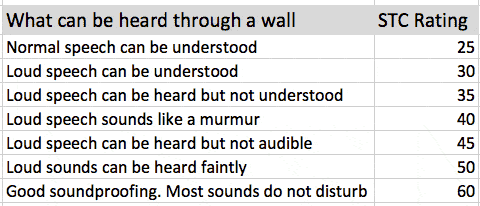
Sound absorption is measured by a Racket Reduction Coefficient (NRC) rating or a Audio Absorption Average (SAA).
In both cases, the higher the rating, the more effective the materials and methods are at doing their job.
To cake loud speech, a wall needs an STC rating of at least forty to 50. For fantabulous racket blocking, you'll demand an STC rating of from fifty to 60.
In each of the soundproofing sections below, nosotros talk over the STC ratings you'll want to achieve.
Dorsum to superlative
Sound Arresting Materials and Techniques
To dampen echoes and reverberations that cause dissonance, absorb sound with soft surfaces and materials. In a typical room, these materials include carpeting, padded curtains, and upholstered furniture. If you want to minimize sound billowy around a room, avert hard materials like hardwood, tile, and laminates.
Acoustic Tiles and Cream
But you can do more than. Audio arresting materials such as acoustic foam tin greatly ameliorate the quality of audio in a room. Typically porous, lightweight, and soft to the touch, sound absorbing materials stop dissonance from billowy around inside rooms. That'southward why they are used for deadening baloney from reflected sound in a home theater, music room, podcasting booth, or recording studio. They work as great to soften the sound in a noisy kitchen or recreation room.
The post-obit educational video explains how audio travels and why reflected audio creates echoes, distortion, and interference. Information technology shows how a combination of sound absorbers and diffusers make a room sound less noisy and more natural.
Back to top
And then, audio-visual tiles piece of work bang-up for decision-making echoes. Only people often ask if putting foam acoustic panels or tiles on walls volition help reduce racket from neighbors or the neighborhood.
The answer is: They keep sound from bouncing around but, across tedious the audio, they won't be very effective at blocking outside racket.
Sound deadening acoustic panels offer studio-quality sound proofing. These home-theater style soundproof foam tiles are available in lots of colors. Shop for sound proofing acoustic deadening sound tiles on Amazon.
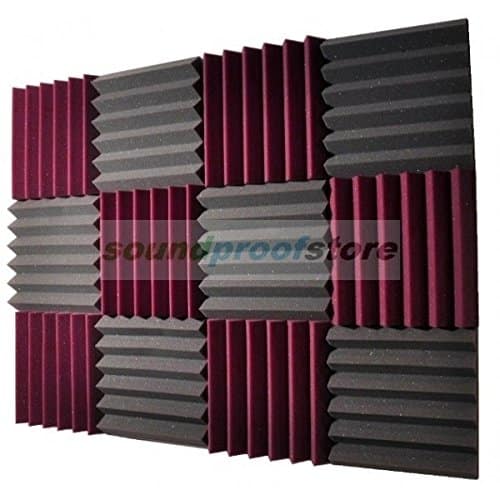
Because foam acoustic panels and tiles are often practical to surfaces equally a finish material, they come in a variety of colors and styles. Cost for acoustic soundproofing tiles ranges from about $15 to $40 for a pack of twelve 12-by-12-inch tiles.
Back to tiptop
Soundproofing for Recording or Podcasting
If two walls are non parallel with 1 some other, sound is less likely to ping pong back and forth. This explains why uneven, angled, curved, or ridged soundproofing materials are popular in environments where noise reduction is fundamental such every bit recording studios, dwelling theaters, and music practice rooms.
For people who are edifice a home recording studio, soundproofing is an art.
A good place to start is with soundproofing acoustic panels or audio slow tiles like the ones shown and discussed higher up.
If y'all're edifice a serious recording studio where y'all don't desire any sound bleeding through the walls, check out this video:
How to Build Acoustic Panels
If you want to make you own acoustic panels for arresting unwanted noise at a cost of less than $20 each, watch this detailed, like shooting fish in a barrel-to-follow video:
Minimizing Uniform Surfaces
The uniformity of a wall or ceiling surface affects its audio manual characteristics. Flat surfaces tend to bounce sound waves around, sometimes creating a lasting echo effect if the surfaces (or walls) are difficult—and especially if they are direct parallel to each other. The less compatible the surface, the less opportunity the sound has to bounce.
Back to elevation
Sound Blocking Materials and Techniques
To block noise coming from exterior a room, such equally traffic dissonance or noisy neighbors, y'all need materials that have a lot of mass. They will work as a sound barrier to minimize sound transmission.
In addition, you may use materials or methods that carve up or "decouple" the parts of a wall or flooring and so that sound waves don't vibrate right through them.
Sound blocking materials prevent noise from traveling through walls, ceilings, doors, windows, and floors. Materials that stop audio are typically dense, heavy, thick, or—in some cases—flexible. Generally speaking, they are too dumbo for noise to travel through them.
A 12-inch-thick brick wall is a good example of a sound blocker. But thick brick walls are rare. Most of united states of america must turn to other materials and methods to accomplish constructive sound blocking.
As y'all'll notice in the information below on how to soundproof rooms, walls, and more, extra-thick layers of drywall, special acoustic "greenish glue," and mass-loaded vinyl (MLV) are amid the best materials for stopping the movement of noise through walls, ceilings, and floors.
The principle that greater mass increases sound blocking holds true for windows and doors, too. Using double- or triple-glazed windows or solid-cadre doors dramatically increases their ability to block audio.
Sound blocking methods. The most constructive audio blocking methods involve building what are finer double walls. The idea is to have these double walls separated so vibrations tin can't pass through them.
Staggered stud configurations, special clips for holding drywall, and multiple layers of ⅝-inch drywall are popular methods decoupling one side of a wall from the other. More nigh these below in Soundproofing a Wall.
Only here is the problem: Unless you're doing a major remodel or building a domicile with audio control equally a priority, employing serious sound-blocking strategies like these can be very expensive and involved. It'southward best to take on these measures when walls and ceilings are already opened upward. If walls are closed upwardly, you may demand to tear them open to change or retrofit them.
If you own your home, the effective, permanent solutions discussed below are possible if you have the budget. We'll walk y'all through a variety of sound blocking solutions.
If you're renting, on the other paw, you'll need affordable, workable alternatives. See Apartment Noise Solutions.
Back to height
Best Soundproofing Doors
Doors play an integral role in controlling the movement of sound through a business firm. Selecting the right doors is i of the easiest and least expensive soundproofing measures you can take to cake sound.
Doors are typically the thinnest barrier in a wall. Because they don't benefit from the thicker—sometimes insulated or layered—construction of walls, they generally do a poor job of blocking dissonance. Dissonance just easily passes correct through them.
Following nosotros'll await at the best doors for blocking sound, too as means to preclude noise from leaking in around them.
Solid Doors Block Sound Meliorate
You can add significant sound control simply by replacing a hollow-cadre door with a solid-core door.
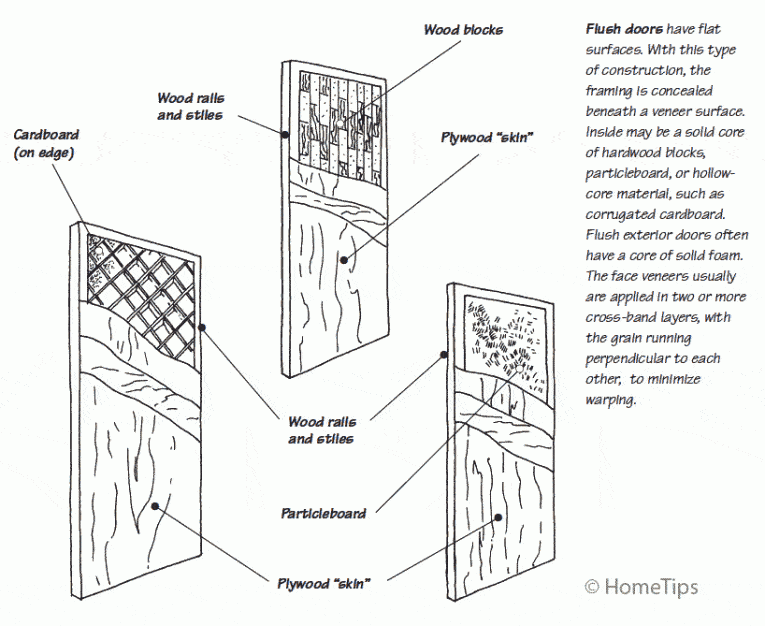
Hollow-core doors are the about typical, ordinary flush interior doors in houses. Below a hollow-core door's surfaces, an inner cardboard honeycomb core is surrounded by a softwood frame. The surfaces are faced with very sparse wood veneers. Considering the thin surfaces and the air-filled core, there isn't much to block the movement of sound.
Solid-core exterior or interior doors have, as their proper name suggests, a solid core of wood or composite material. They will cake racket more effectively because of their density. Manufacturers sell many types, ranging from expensive hardwood to more than affordable Medium Density Fiberboard (MDF) doors.
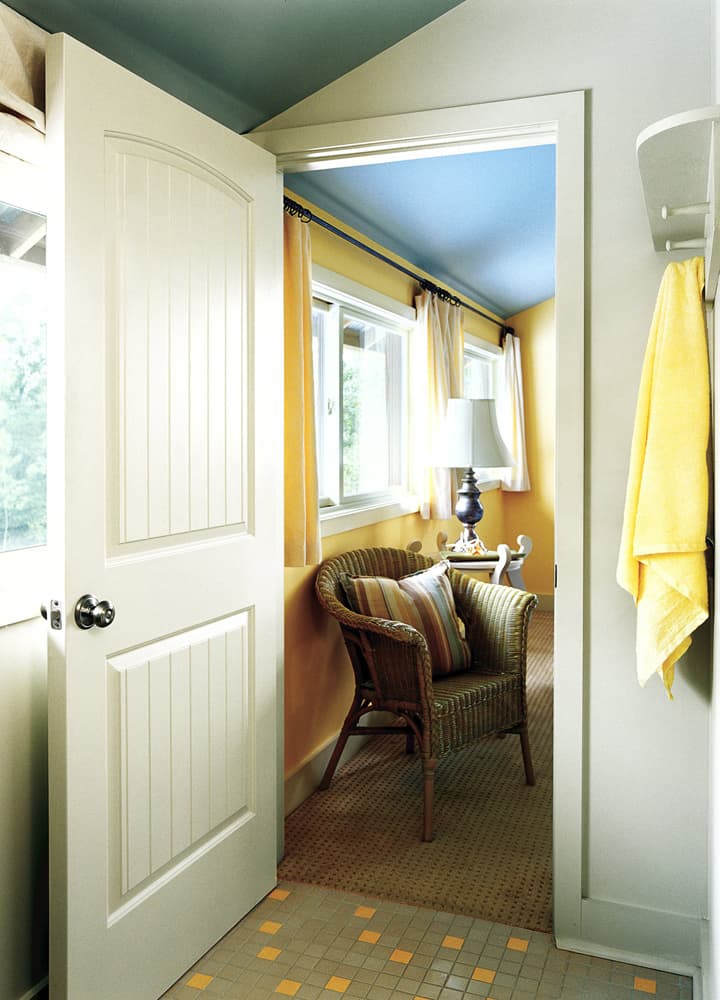
When shopping for a audio-blocking door, you'll meet they all have an STC rating that measures their operation. Delight run into What Is An STC Rating?
A hollow-cadre interior door has an STC of less than 20. If you were to replace that door with a solid-core door that is properly weather stripped, you would end up with an STC rating of 34 to 36. This would block low oral communication, simply not loud oral communication or other racket.
Though most interior doors are 1 3/viii-inch thick, outside doors are typically ane 3/four-inch thick. The thicker the door, the ameliorate it reduces noise transfer. Just exist aware that replacing a 1 ⅜-inch door with a thicker one volition involve some carpentry modifications to the door jambs.
Audio-blocking doors. You can actually go ane step further than a solid-core door and buy a sound-blocking door. Doors fabricated specifically for blocking sound typically have a structure that sandwiches ane/ii-inch-thick particle lath sound lath with an interior layer of lead or another super-dense material. (A door that contains lead will exist much heavier than a conventional door.)
They are often sold every bit kits that include jambs and integral interlocking thresholds and sweeps to keep sound from leaking-in around them.
Back to superlative
Weather Stripping for Doors and Windows
Of course, information technology doesn't matter how a door is built if it'southward open, right? Similarly, if gaps exist around the edges or betwixt the bottom of the door and the floor, sound easily sneaks in around the door.
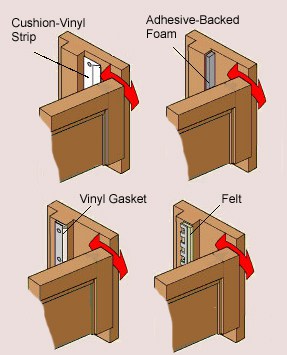
Then the door should fit the jamb tightly. Use atmospheric condition stripping to seal effectually its edges. Rubber or vinyl bulb door weather stripping and a door-bottom weather condition stripping sweep do a good task of sealing around the perimeter of a door to cake noise.
Shop door weather stripping and door sweeps on Amazon.
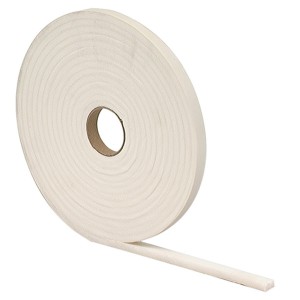
If you lot need a door sweep that doesn't drag along the floor, investigate an automatic door sweep that seals the bottom of the door merely when the door is airtight.
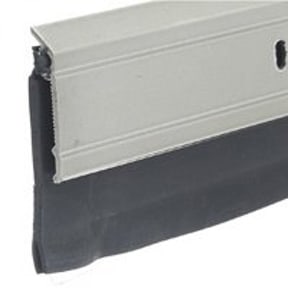
You lot can purchase recording-studio-grade door dissonance-reducing materials online as an audio-visual door seal kit.
Dorsum to peak
Soundproofing a Wall
Whether you lot want to command the noise inside a room or cake it from traveling into a room, your home'due south walls are key. Proceed in heed that nearly soundproofing techniques used for walls also work for ceilings.
Unfortunately, conventional walls and ceilings are merely marginally effective at blocking dissonance considering they are built similar drums.
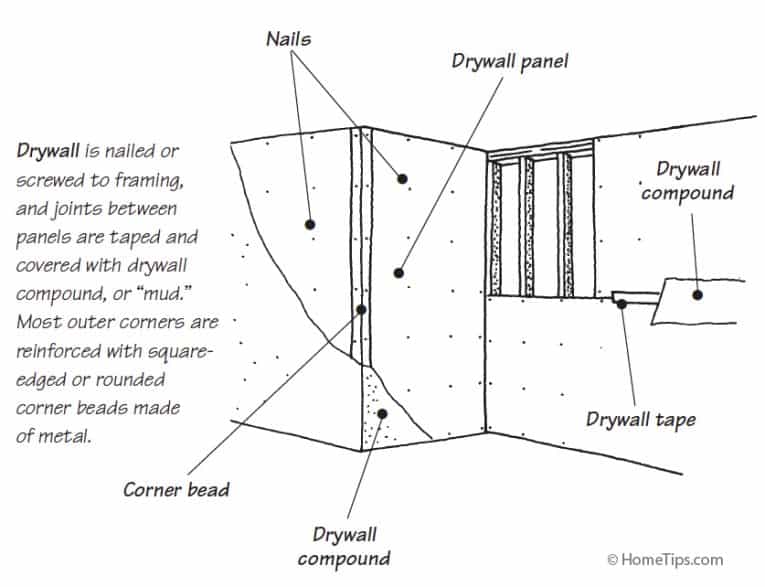
They have surface membranes (typically ½-inch-thick drywall) attached to a structural framework of wall studs or ceiling joists. The spaces betwixt the studs are filled with air or, in some exterior walls, insulation.
When sound waves strike one surface, they are conducted through the surface material and framework to the other surface where they're broadcast as audible noise.
Of grade, where wall surfaces are thin or nonexistent, such every bit at an open up window or doorway, noise flows freely.
STC Ratings for Walls
As a standard for comparison, a "paper-thin" conventional firm interior wall made of 2-by-4 studs with 1/2-inch drywall on both sides has an STC rating of betwixt fifteen and 33. The variance depends upon construction and whether the wall contains fiberglass insulation.
A 2-past-four stud wall, insulated, with slightly thicker ⅝-inch drywall on each side will give you an STC rating of most 40. (See What Is An STC Rating?)
Many condos or apartments have segmentation walls congenital with staggered double two-by-4 stud framing and, in some cases, one or 2 layers of ⅝-inch drywall on each side. These have STC ratings from twoscore to the high 60s, depending upon the number and thickness of drywall layers and the improver of insulation between the studs.
Mass-loaded vinyl, discussed beneath, contributes an additional STC rating of from 25 to 27.
Dorsum to summit
Soundproofing Insulation
If you are building or remodeling a home, you have an excellent opportunity to install pregnant noise control measures, including insulation between the studs and several acoustic structure techniques discussed below.
During edifice or remodeling, an effective and affordable way to improve the soundproofing performance of walls and ceilings is to put batt or blanket insulation betwixt studs or joists. Insulation absorbs the sound that would otherwise easily travel through the air pockets betwixt wall framing.
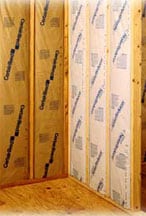
Major insulation manufacturers, including CertainTeed, Johns Manville, Knauf Fiber Drinking glass, and Owens-Corning, marketplace 3 1/2-inch-thick fiberglass or rock wool "acoustic batts" specifically for audio control. These products are excellent at absorbing the sound that would otherwise travel through the air.
Designed to fit betwixt studs, acoustic batts are xiv one/ii inches or 22 1/2 inches broad and three 1/2 inches thick. Most are the aforementioned equally R-11 or R-13 energy insulation batts.
Kraft-faced batts are friendliest to handle and easiest to fasten in place (a vapor barrier is non needed for interior walls). They should exist installed tightly between framing members, and snugly around pipes, electrical boxes, wires, and heating ducts with every bit few hollows or gaps as possible. Any gaps or hollows will allow dissonance leaks.
Leaving only a small portion of a wall or ceiling uninsulated can dramatically reduce its audio-reducing performance. Batts can be friction-fit in wall cavities. If temporary support is needed, two or three bands of drywall record may exist stapled horizontally across studs.
In ceilings, batts should be installed just above the backside of the ceiling textile.
Structure Methods for Acoustic Walls
Boosting the sound-blocking performance of walls and ceilings to higher STC levels calls for additional measures during wall construction. Here are a few options:
Metallic wall studs. Using metal wall studs helps. A wall built with 2 one/2-inch metal studs yields an STC rating of 45.
Ii layers of drywall. Another fashion to reach improve performance is to apply a 2nd layer of 5/eight-inch drywall to ane or both sides of the wall. This gives the surface more mass, making it less prone to vibrate and transfer sound waves.
Adding a layer of ½-inch drywall to one side of an insulated wall increases the STC rating to 40; calculation information technology to both sides pushes the STC to 45. Past moving up to ⅝-inch drywall and adding insulation y'all can go an STC rating as high as 60.
Audio isolation systems. An even more effective way to build an interior wall is to mount 1/two-inch gypsum wallboard on special resilient channels or clips that beyond the wall. These channels or clips absorb sound so information technology isn't conducted through the wall studs, resulting in an STC rating of well-nigh 46.
Typically, the drywall is screwed to a flange on the channels, not to the studs. Combining insulation, channel-mounted wallboard, and a dual layer of 1/2-inch gypsum on 1 side achieves an excellent STC rating of 52.
This video shows how to install drywall on the CertainTeed racket-proofing clip system:
Staggered wall studs. In roughly the same category is a wall with staggered wall studs. Though this requires more labor and framing material, a wall of 2-by-4 studs, staggered along two-past-6 bottom and top plates with two thicknesses of fiberglass insulation, produces an STC of about l. Considering the wall surfaces are each fastened to an independent set of studs, noise can't travel through the studs from ane surface to the other.
Fireblocking. Where codes and safety allow, consider eliminating fireblocking in interior walls. These short blocks, mounted horizontally between wall studs, transmit noise readily from 1 wall surface to the other. If you're thinking about eliminating them, exist sure to check with your local building section.
Back to top
Mass Loaded Vinyl (MLV)
Mass Loaded Vinyl (MLV) barriers offer a serious step-up in blocking sound, with an STC add-on of from about 25 to 32. Made of high-density organic sands and salts, as well as minute metal particles, these 1/8 to 1/4-inch-thick flexible products are sold in four-past-8-human foot sheets and four.5-by-20-foot rolls. The material can be cut with a utility knife.
MLV tin be Class A E84 fire rated when it has a foil facing on it.
Prices run from $1 to $2.l per square foot. You can purchase self-agglutinative types, only this adds to the price.
At about 2 pounds per square foot, they are heavier than they expect. Depending upon the surface you're attaching them to, you can apply construction staples, nails or screws with big washer-sized heads, or adhesive. A power nailer loaded with staples is easiest to use. Because of the weight, MLV must be installed so that the fasteners don't pull through the material.
Y'all can even install grommets and hang the sheets like curtains (a skilful solution if you live in an flat or rental).
The following video shows how to install Acoustiblock, i of the bachelor MLV systems.
Sealing Up Wall Penetrations
Electrical switches and outlets are set into plastic or metal boxes in a wall. These boxes, because they are hollow, act as holes that let dissonance to easily laissez passer through the wall.
This is where Putty Pads or Quiet Pads can help. If you can gain access, wrap the back side of electrical boxes and similar penetrations with putty pads. These create an air seal and add together mass to the box that sound tin't featherbed.
This video shows how to employ the pads. The host as well discusses applying a double layer of ⅝-inch drywall and filling cavities between wall studs with fiberglass insulation.
Back to top
How to Soundproof Between Floors
In an existing home or apartment, controlling the racket that travels from the floor higher up to the room below (or vice versa) tin can exist very hard, particularly if you don't own or command the room above. For more than about this, please see How to Soundproof an Flat.
If you lot own the room above, y'all tin install padded carpeting to minimize the audio of shoes above or foam speaker isolation pads to deaden the rumble of speakers. You can likewise undertake repairs such every bit silencing floor squeaks.
How to Build a Soundproof Floor Video
If y'all're building a new home or undertaking a major remodel, and you desire to make sure that the racket to a higher place is non heard in the room below—and vice versa—you can build a soundproof floor.
Yous do this by pouring a 1½-inch slab of lightweight concrete on the floor. This, of grade, will be major construction that involves pumping and troweling concrete. Be aware that this technique will heighten the floor level by at least ane½ inches, so this must be taken into consideration during your planning.
Here is a video that shows y'all what is involved in building a soundproof flooring:
A floor-ceiling construction that produces an STC of 53 is achieved by mounting 1/2-inch gypsum wallboard to resilient channels attached to two-by-10 ceiling joists with 3 1/2-inch-thick batts betwixt the joists. In this scenario, the floor above has a plywood subfloor, particleboard underlayment, carpet pad, and carpet.
Back to top
Basement Ceiling Soundproofing Video
Beneath is an excellent video that shows you iv unlike methods for soundproofing a basement ceiling so you don't hear the dissonance to a higher place, and the people in a higher place don't hear the dissonance in the basement.
The first, easiest and probably best method he illustrates is to apply to layers of ⅝-inch drywall with "dark-green glue" to create a super-dense ceiling with an STC rating of almost 40, which is ample in near situations. This pick doesn't involve installing insulation.
He explains that you tin add more sound dampening past calculation fiberglass insulation. Note: We recommend wearing a long-sleeve shirt, gloves, a dust mask, and safety glasses when installing fiberglass insulation.
Ceiling Sound Absorption
To assistance serenity the racket of a room that is below other rooms, you tin install an acoustic ceiling.
Companies such as Armstrong Globe Industries have a wide range of acoustic ceiling materials that are particularly popular for deadening the sound within a room and can help cut down on dissonance transference to and from basements and other activity areas.
Acoustic tiles and drop-ceiling systems offer excellent acoustical properties.
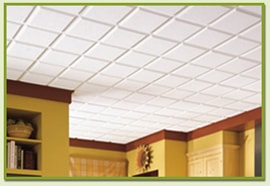
You might be pleased to find that they don't have to await similar an part ceiling. People who think the conventional styles of acoustic ceilings are a bit too institutional will similar some of the newer styles available.
For instance, Armstrong offers 2-by-2-foot and 2-by-4-foot acoustic ceiling panels that take a footstep-edged particular or wait similar embossed or molded plaster. "These are very good for blocking noise generated in the basement and keeping it from invading upstairs," says a spokesperson for Armstrong's residential ceilings. "They will give your basement ceiling an STC rating of about 35 and even better performance if you install batt insulation between flooring joists," he adds. (For more about STC, run into What Is An STC Rating?)
With ceilings, as with the entire house, the most effective style to minimize noise is to combine a number of different sound-blocking and sound-reduction methods.
Dorsum to top
Soundproofing Windows
Noisy neighbors, traffic, animals, leaf blowers, lawnmowers, pumps, airplanes, construction: these are just a few of the noises that can interrupt your domicile's peace and quiet.
Simply what tin can y'all do about them?
The respond is that it may largely depend on the type of racket and the work and expense you're willing to go to block the noise.
Replacing Windows with Soundproof Windows
Replacing former single-pane windows with special soundproofing windows can be a huge—though expensive—step.
Ane of import note is that energy-efficient windows and soundproof windows are two different things. Glazing that has argon gas and depression-E coatings doesn't change a window's audio-visual features. The thickness of the glass, the corporeality of space between panes, and the integrity of the frame practice.
Because conventional unmarried-pane windows exercise very little to block noise, they are a significant target when it comes to soundproofing to close-out exterior racket. A single-pane window has an STC rating of 18 to 27. (See What Is An STC Rating?)
A dual-glazed (or "double-glazed") window has an STC rating of 28 to 32. Dual glazing may be a significant energy improvement for your home, merely as a soundproofing comeback, the change is only slightly audible. You need to move upwardly to a college performer to significantly block noise.
Laminated dual glazing steps up the STC to about 35, but this difference over basic dual glazing doesn't justify the boosted high price of laminated glass. The aforementioned is true of triple glazing.
A better selection is choose double glazing that has two unlike thicknesses of glass. These windows do a ameliorate job of filtering out various frequencies of noise and volition evangelize an STC rating of most 34.
Well-nigh major window manufacturers offer special soundproofing windows, so check effectually. And be certain to get multiple bids if you're thinking seriously about this type of major investment.
Installing Soundproof Window Inserts
If y'all live in an airport flying path, a noisy downtown area, or merely a subdivision with too many leaf blowers, you're going to want windows with an STC of 38 to 40 or more than.
In this case, investigate special soundproofing window inserts. These are far more affordable than completely swapping out windows.
Soundproof window inserts are custom-made to fit and be installed inside many types of existing windows.
When installed, these windows get out a hefty infinite of about four inches between the existing window and the insert. As a result, they achieve very loftier STC ratings of 38 to 42.
They are made in a variety of operable styles past companies such as CitiQuiet, Indow Windows, and Citiproof Soundproof Windows. Certain brands are sold through major habitation improvement retailers.
Window Soundproofing Panels and Audio-visual Quilts
Sound reducing acoustic defunction are an cheap fashion to absorb some interior room sounds and can marginally minimize outdoor noise. You can buy purchase sound-blocking curtains on Amazon for nether $40. But keep your expectations depression—they are not going to practice an exceptional job of keeping out the dissonance.
Noise-reducing defunction blot indoor sound and help cake outdoor noise.

Acoustic curtains will be most effective if you choose sizes that will achieve from ceiling to floor. At the very to the lowest degree, they should extend a few inches beyond the perimeter of a window.
This video shows how i brand of soundproofing panels is easy for a exercise-information technology-yourselfer to buy and install.
Caulk and Weather condition Strip Windows
Gaps and spaces around windows allow noise to pass freely. 1 of the cheapest but well-nigh effective soundproofing measures y'all can take is to weather strip and caulk windows. For more than, meet How to Weather Strip Doors and Windows.
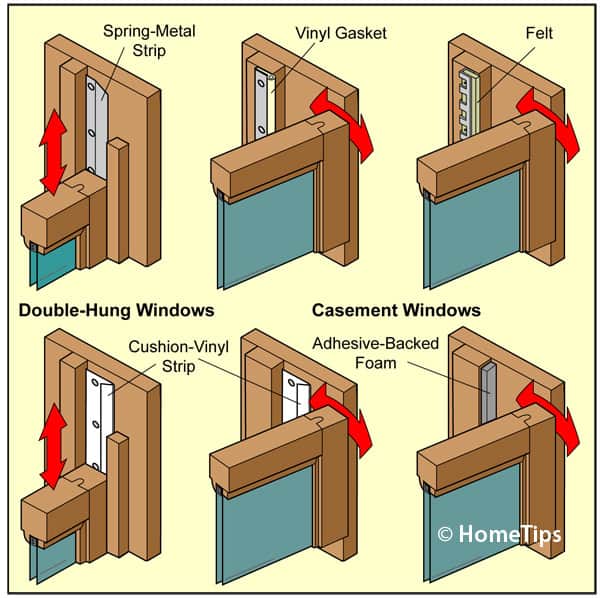
Back to top
Soundproofing A Garage
If your dwelling has a room side by side to or in a higher place the garage, street noise tin can travel right through the garage into your house. In this situation, the makeup of your garage door is also a consideration.
The typical garage door is built with an open interior framework and faced with a sail of plywood, steel, vinyl or aluminum on the outside.
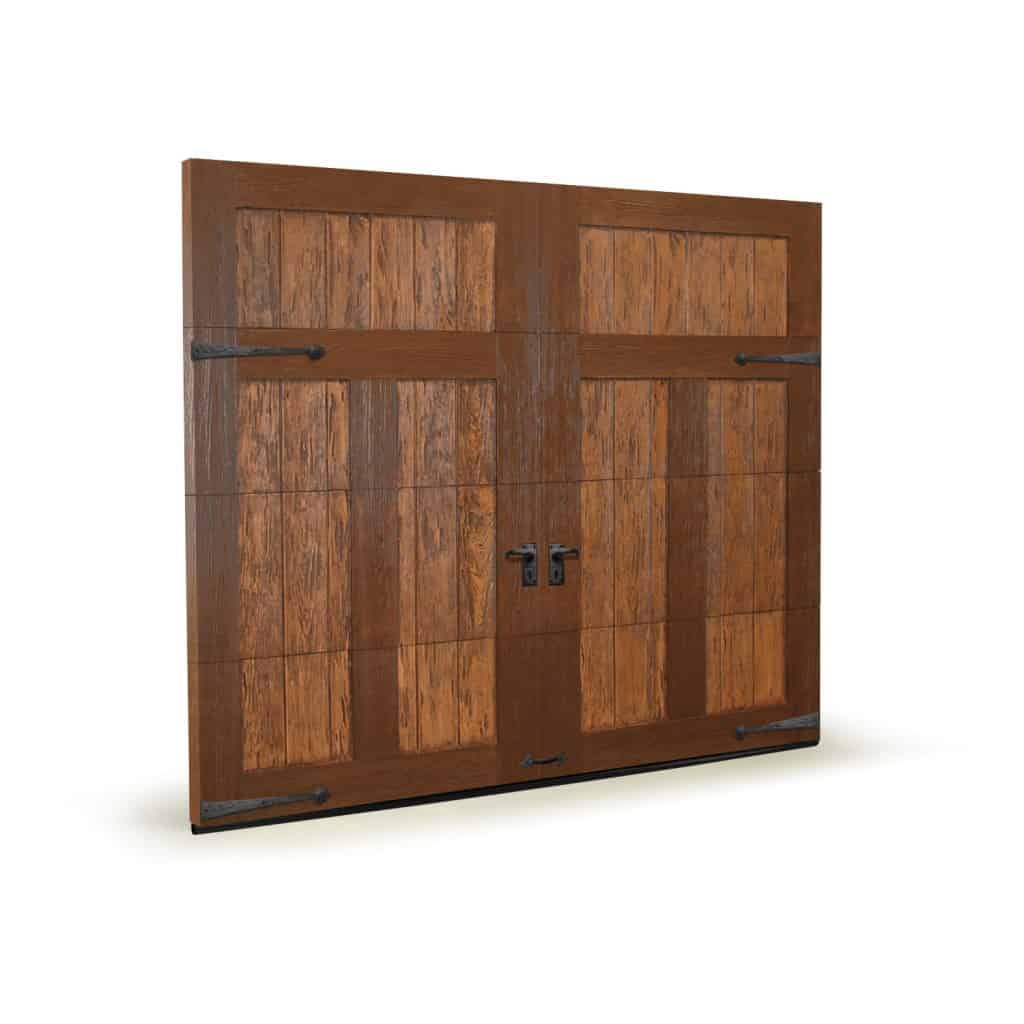
But you can purchase premium garage doors that are filled with cream insulation and take an additional facing on the inside. These are especially good at keeping street noise from inbound through the garage.
For more, meet the Garage Doors Buying Guide.
Back to height
Soundproofing An Apartment
Some sound control issues are not easy or affordable to solve completely because they can involve opening up and reconstructing walls, ceilings, and floors. Plainly, if you alive in a rental or apartment, these methods are not practical.
But what can yous do to cut downwards on noise from side by side-door neighbors or an flat above or below y'all?
Your best measures are going to be those with neighbor compliance or participation. If you have a positive human relationship with your noisy neighbors, discuss the issue and run into if you tin piece of work out a solution together. For example, if their subwoofer is pounding your ceiling with bass tones, maybe you tin offering to purchase them a set of audio-visual foam isolation pads for their speakers.
If the sounds of clicking heels or heavy pes falls are pounding the ceiling, see whether they might put padded carpeting or rugs in the about problematic rooms.
If the problem is floor squeaks, talk to your landlord.
If the noise is coming through walls, endeavour to adjust furniture to control information technology. For example, consider putting a floor-to-ceiling wardrobe or bookcase against a noisy wall. Yous might even put mass loaded vinyl (MLV) behind it on the wall or the back of the bookcase or wardrobe.
Exist certain to check out the sections above on Best Doors for Sound-blocking and Acoustic Panels and Quilts in Soundproof Windows.
Dorsum to top
preslarappirdsmanne63.blogspot.com
Source: https://www.hometips.com/buying-guides/soundproofing-insulation.html
0 Response to "Does Soundproofing a Wall Help Agains Running"
Postar um comentário